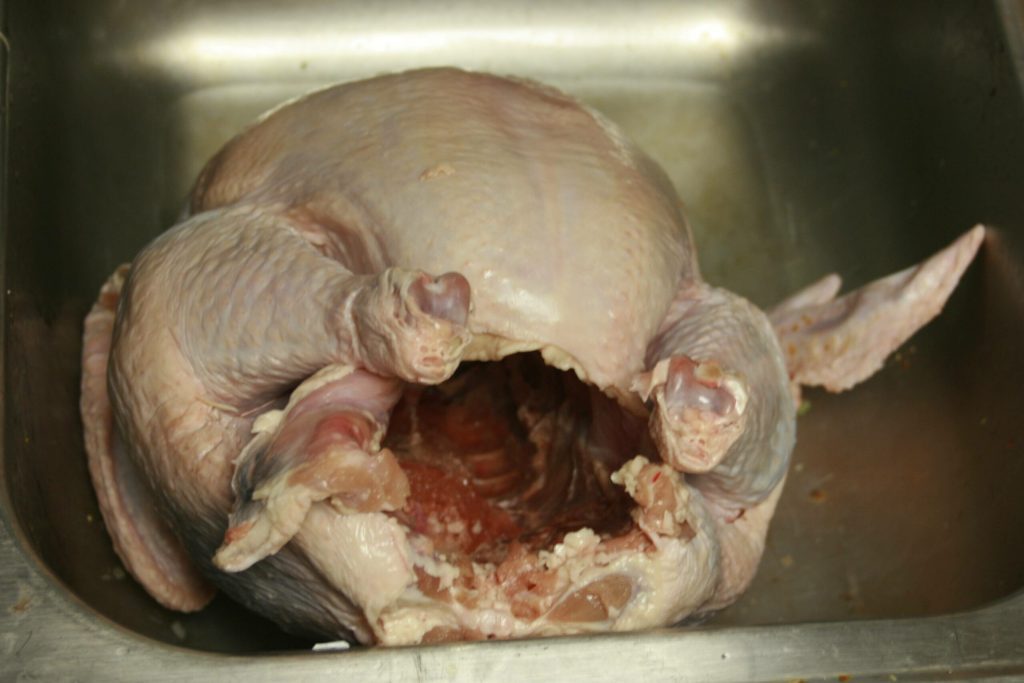The holiday season is upon us—that is, of course, if you celebrate Christmas or capitalism. Regardless, the season brings homemade treats and feasts, and the crushing paranoia of new home chefs who were perhaps too ambitious with their menu and guest list. So much can go wrong. For example, you may accidentally give your guests food poisoning.
I haven’t found good data on how many such poisonings occur this time of year, but there are annual estimates. According to the Centers for Disease Control and Prevention, 48 million people get food-borne illnesses every year. Out of those, 128,000 are hospitalized and 3,000 die.
So, how do you feed your hungry friends and family without feeding them nasty pathogens? Our Modern Plagues has your back. And, fair warning: You might not want to read this if you’re eating.
Turkey
Ah, the Christmas poultry that we love to hate. According to the National Turkey Federation, the most common turkey food-borne pathogens are:
-
Campylobacter jejuni, a bacterium that causes nasty diarrhea “which may be watery or sticky and can contain blood”
-
Clostridium perfringens, another diarrhea-causing bacterium
-
Escherichia coli O157:H7, perhaps the most infamous diarrhea-causing bacterium, which can start watery but turn “grossly bloody”
-
Listeria monocytogenes, a bacterium that sometimes causes diarrhea, as well as fever, fatigue, and aches and is especially dangerous for pregnant women, babies, and people with compromised immune systems
-
Salmonella, a group of bacteria that cause fever and diarrhea
-
Shigella, a group of bacteria that also cause fever and diarrhea
-
Staphylococcus aureus, a bacterium that is commonly found in around a quarter of us in our noses and on our skin, can withstand high cooking temperatures, and causes diarrhea and vomiting.
Not every turkey will be carrying all of these pathogens, of course. Still, that’s a lot of diarrhea. Plus, the CDC reports that when it comes to food poisoning, poultry accounts for more deaths than any other food. If you must eat turkey, make sure to handle it carefully before you cook it—if it’s harboring pathogens, these may contaminate anything it touches. Keep the raw turkey separate from other food and use dedicated utensils and cutting boards (clean them with hot water and soap after use). As for washing the turkey itself: Don’t do it. When you plop a turkey in your sink and rinse it off, you can splash pathogens all over the place. (Here’s a good FAQ on the topic at NPR’s The Salt.)
Also pay attention to the turkey’s temp. Don’t let raw birds sit out at room temperature for too long, even when thawing, as pathogens such as C. perfringens and S. aureus flourish in these conditions and can withstand high cooking temperatures later on (in particular, avoid the so-called “danger zone” of 40 to 140 degrees Fahrenheit).
Invest in a meat thermometer and make sure the interior of the bird hits 165 degrees Fahrenheit when it’s cooked. Here’s a guide from the USDA with cooking times and tips for turkeys that are fresh, frozen, and more.
Stuffing
If you’re gonna stuff the bird, do it right before it goes in the oven and make sure it cooks all the way through—all those turkey juices seeping into the stuffing could otherwise make someone sick. A safer option is to cook the stuffing separately to make sure it cooks all the way through. Here are more tips from the USDA.
Salad
It may be surprising, but leafy greens cause more outbreaks than any other food, according to a 2013 CDC report. A wide range of pathogens may end up on the salad from any point in the production chain. Recent examples include E. coli, the parasite cyclosporiasis, and norovirus, a virus that’s the most common source of food-borne illness in the U.S. and—surprise surprise—causes diarrhea, as well as nausea, vomiting, fever, headache, and body aches.
Be sure to use a dedicated a knife and cutting board for lettuce and vegetables so that juices from turkey or other meats don’t get tossed in. The Food Poisoning Bulletin also has some reasonable tips on picking lettuce and keeping it clean.
Green bean casserole
Like lettuce, a range of nasties could contaminate green beans and other fresh vegetables. Unlike lettuce, if you’re cooking these vegetables, you should be able to kill off most pathogens. If you’re using canned green beans, check the can for unusual bulges or major dents and toss out any cans that contain foul-smelling or frothy contents. These are all potential signs of Clostridium botulinum, a bacterium that produces the dangerous botulism toxin. While relatively rare, this neurotoxin is among the most dangerous in the world and can be deadly.
The good news is that deaths from botulism have dropped drastically over the past 50 years. The other good news is that C. botulinum is very sensitive to heat: according to the CDC, boiling food for just 10 minutes will destroy the pathogen. (Of course, if you see obvious signs of contamination, it’s better to just throw the food out and wash contaminated areas with bleach.)
Eggnog
According to the CDC, dairy caused more hospitalizations from food poisoning than any other type of food from 1998 to 2008, and raw eggs are a well-known risk for salmonella (although, in reality, that risk may be pretty small. Still, homemade eggnog made with raw eggs and lots of cream—and also lots of booze—may be safer than the store-bought variety, at least according to one admittedly small study at the Rockefeller University. Here, I even have a recipe for you at this old blog post.
Take-out
If you want to avoid holiday feasts altogether, there’s always take-out. But beware: restaurants and fast-food joints have food poisoning outbreaks, too. Just ask Chipotle.









